Superorder Pteriomorphia Beurlen, 1944
Order Ostreoida Ferussac, 1822
Suborder Pectinina Waller, 1978
Superfamily Buchiacea Cox, 1953
Family Monotidae Fischer, 1887
Type-genus: Monotis Bronn, 1830
Diagnosis: Distinctly inequivalve to subequivalve, inequilateral prosocline, sub-round shell outline; test thin; left valve slightly to more strongly convex than right valve with tiny anterior auricle; byssal notch narrow and deep under the auricle; left valve without distinct anterior wing; posterior wing clearly separated or nearly con-tinuous from disc, and obtusely or rectangularly truncated; ligament external, forming narrow, triangular and shallow area; ornament usually consisting of fine to thick radial plicae which increase by insertion, but in aberrant forms radial plicae absent and irregular concentric wrinkles developed; shell structure unknown.
Other genera: Otapiria Marwick, 1935 and Lupherella Imlay, 1967
Discussion: Though this taxonomic group was at first proposed as a subfamily by Fischer (1887), there is a general agreement that it should be treated as a distinct family (Hertlein et al., in Cox et al., 1969). Different ideas as to the constituent genera of the Monotidae, however, have been presented. Imlay (1967) considered Otapiria and Lupherella as members of the Monotidae. Hertlein et al. (1969) in the Treatise, however, referred Otapiria to the Aviculopectinidae, notwithstanding that Pleuromysidia Ichikawa, 1954a, which seems to be a junior synonym of Otapiria, was questionably included in the Monotidae. According to the Treatise (p. N339), "the general form of the shell and the small size of the auricle [of Otapiria] suggest affinity with the Monotidae, but the pres-ence of a triangular ligament pit precludes reference to that family." But taking other characters into account, this treatment is thought to be opportunistic. There are insuffi-cient differences between Otapiria and Monotis to warrant placement in different families.
Recently, Waterhouse (1982) proposed the Otapiriinae of the Pseudomonotidae, and transferred Claraia and probably Asoella to this subfamily. Because of the scarce evi-dence for the phylogenetic relationship between Claraia and Otapiria, I do not adopt this new subfamily.
As to the major classification of pteriomorph bivalves, Waller (1978) presented a new system using cladistic analysis. He proposed the superfamily Buchiacea [ex. Buchiidae Cox, 1953]. In addition to Buchia, Aucellina and some other genera included by Cox (in Cox et al., 1969) in the Buchiidae, several genera assigned by Cox and Newell (in Cox et al., 1969) to the Monotidae, Oxytomidae and Pseudomonotidae, were also in-cluded in this superfamily. Furthermore, Asoella, Claraia, Leptochondria, Otapiria, Oxyptera and Ornithopecten, which had been assigned by Newell, Cox and Hertlein (in Cox et al., 1969) to the Aviculopectinidae, were said also to have Buchiacean features. Consequently, this superfamily seems to include many Upper Paleozoic and Mesozoic thin-shelled pteriform pectinoids with a minute anterior byssal auricle. Waller (1978, 1984), however, did not mention the taxonomic position of the Posidoniidae. Waller's classification is tentatively adopted in this paper.
Quite recently, Payevskaya (1985) presented the result of the logical-mathematical (numerical taxonomic) analysis of Monotis and related genera. In that study, she proposed a elassificatory scheme in which Amonotis and Claraia are also included in the Mono-tidae. But at present, detailed discussions of the scheme are left pending, owing to a lack of evidence.
Genus Monotis Bronn, 1830
Type-species: Pectinites salinarius Schlotheim, 1820 (subsequent designation, Herr-mannsen, 1852)
Diagnosis: Moderate- to large-sized, thin-shelled, weakly to strongly inflated, sub-equivalve to strongly inequivalve with less inflated or flat right valve, outline subcircular, subquadrate or suboval, commonly posteroventrally expanded; posterior wing small to moderate, obscurely to clearly separated from the main part of valve, and sharply or obtusely truncated; anterior auricle minute and projected obliquely inward and upward; byasal notch narrow but deep with pseudoctenolium on upper and lower side; ligament external and of alivincular type, with longitudinally striated area; ligament pit shallow and small.
Remarks: Excellent discussions about the systematic position of Monotis have been provided by Ichikawa (1958), Westermann (1962, 1973a, b) and Grant-Mackie (1978a). The above diagnosis is nearly the same as the last author's. Though there are few problems about its generic validity, different opinions have been expressed about infra-generic division. When Ichikawa (1958) settled previous taxonomic confusion, he divided the genus into two subgenera, namely Monotis (s. s.), having subequivalve shells with a very small byssal auricle, and M.(Entomonotis) Marwick, 1935, having inequi-valve shells with rather a larger auricle and notch. Westermann (1966) did not accept this dichotomy, but subsequently (1973b) classified Monotis into five species groups on the basis of morphologic similarity and geographic distribution; namely the M. salinaria, M. ochotica, M. subcircularis, M. scutiformis and M. sabaikalica Groups. A detailed historical review up to 1977 was given by Grant-Mackie (1978a). In the same paper he proposed the division of Monotis into five subgenera, emending Westermann's grouping and proposing the last three subgenera; i.e. Monotis (s. s.), M. (Entomonotis), M. (Eo-monotis), M. (Inflatomonotis') and M. (Maorimonotis). The distribution of the last two subgenera is restricted to the Maorian province.
Tozer (1980b), though provisionally, proposed a tripartite generic division, with Monotis Bronn (including Entomonotis Marwick), Eomonotis Grant-Mackie and Maori-momtis Grant-Mackie as distinct genera.
Grant-Mackie's subdivision was based on the shell outline, degree of inequivalveness,
shell ornamentation, and the separation and plication of the posterior wing. As described in Chapter 5 (pp. 58-66), all of these characters are extremely and continuously variable. In some cases, variable states of these characters, on which his subgeneric division was based, are found in. a single population sample. So far as I have observed Japanese samples, some of the unstable characters are inadequate as diagnostic criteria for sub-generic separation. For the time being, I follow Westermann's classification with some emendation, and do not use subgeneric divisions.
Recently, Payevskaya (1985) published an all-inclusive study of Monotis in terms of the numerical taxonomic method. She recognized 6 species groups, 32 distinct species and 6 subspecies in the world, as well as 10 forms in the nomenclature which are not valid. Her division into 6 species groups is generally similar to my one. As stated in Chapter 5, however, the recognition of Monotis species should be made from the viewpoint of the population concept, considering intrapopulational variations. Though she used the numerical taxonomic method, the treatment with materials from various areas in various horizons was still typological.
Stratigraphic occurrence: According to Westermann (1973b) and Tozer (1980a, b), it is confirmed that Monotis in British Columbia is found only within the two ammonite zones, Himavatites columbianus and Gnomohalorites cordilleranus, being correlative with upper Middle Norian and lower Upper Norian respectively, or Upper Norian and Lower Rhaetian (Table 1; see Chapter 3). Biostratigraphical data from ammonites in other regions including Japan are too scarce to allow significant correlation.

Table 1 |
Geographic distribution: Almost cosmopolitan, especially Tethys and Circum Pacific regions (Fig. 38).
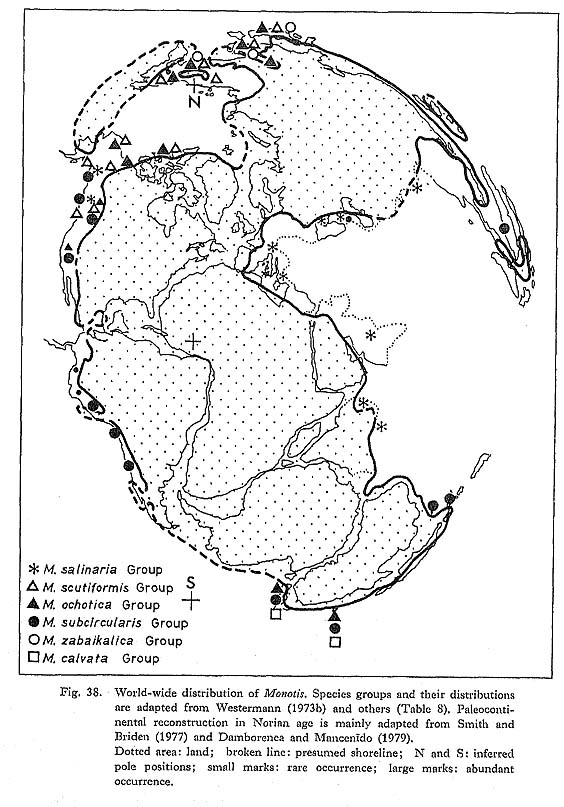
Monotis scutiformis (Teller, 1886)
Pl. 4, Figs. 1-24
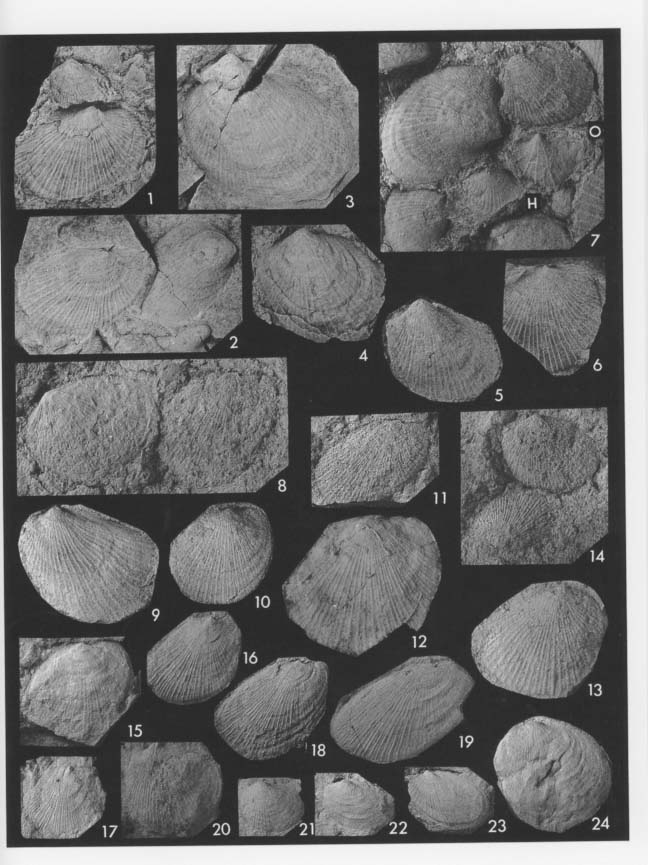
Explanation of Plate 4
Monotis scutiformis (Teller)
Utatsu sample (loc.: Sr3201d), Shirayamazawa section
Fig. 1. Top: left valve; bottom: right valve (MM15710)
Fig. 2. Left: right valve (MM15713); right: left valve (MM17578a)
Figs. 3-5. Left valves; Fig. 3 (MM15711); Figs. 4-5 (MM17578b,c)
Fig. 6. Right valve (MM15714)
Fig. 7. Crowded occurrence on a slab with Halobia sp. (H) and Oxytoma sp. (O) in poorly sorted, medium-grained sandstone; type III; top: left valves (MM15712)
Kesennuma samples (locs.: Keb-q)
Fig. 8. Left: left valve; right: right valve; valves of the same size suggest that they are of the same individual; type IV; loc.: Keb (MM17581a)
Fig. 9. Left valve, loc.: Kep (MM17584)
Figs. 10-11. Right valves, loc.: Keb (MM17581b)
Fig. 12. Right valve, loc.: Keq (MM17585)
Fig. 13. Right valve, loc.: Kel (MM17583)
Fig. 14. Top: left valve; bottom: right valve; loc.: Keb; The same slab as in Fig. 8 (MM17581c)
Asa samples (locs.: As5, 6)
Figs. 15-17. Right valves, loc.: As5 (MM17587a-c)
Figs. 18-19. Right valves, loc.: As6 (MM17586a, b)
Figs. 20-21. Left valves, loc.: As5 (MM17587d, e)
Figs. 22-24. Left valves, loc.: As6 (MM17586c-e)
All are natural size. Figs. 12, 20 are latex casts from external molds. Others are internal molds
|
1886 Pseudomonotis scutiformis Teller, in Mojsisovics, p. 125, pl. 19, figs. 3a, 3b
1910 Pseudomonotis scutiformis Teller: Wittenburg, p. 68, pl. 5, figs. 3, 9, 10
1932 Pseudomonotis scutiformis Teller: Kiparisova, p. 21, pl. 1, figs. 14-18 (not seen)
1936 Pseudomonotis scutiformis var. typica Kiparisova, p. 118, pl. 1, figs. 6, 7, 9, 10
1936 Pseudomonotis scutiformis var. kolymica Kiparisova, p. 118, pl. 1, figs. 8, 11, 12-14
1938 Pseudomonotis subcycloidea Kobayashi, p. 29, pl. 7, fig. 1
1958 Monotis (Entomonotis) typica Kiparisova: Ichikawa, p. 180 (mentioned only)
1960 Monotis daonellaeformis Kiparisova, p. 26, pl. 5, figs. 3, 4 (not seen)
1961 Monotis ochotica (Keyserling): Tozer, p. 106, pl. 30, figs. 1-3 (only)
1961 Monotis (Entomonotis) typica (Kiparisova): Hase, p. 80, pl. 12, figs. 1-11
1961 Monotis (Entomonotis) mukaihatensis Hase, p. 83, pl. 12, figs. 12-18
1962 Monotis scutiformis pinensis Westermann, p. 757, pl. 112, figs. 10-24
1964a Monotis (Entomonotis) typica (Kiparisova): Nakazawa, p. 31, pl. 3, figs. 4-8, pl. 4, figs. 1, 2
1964a Monotis (Entomonotis) sp. aff. iwaiensis Ichikawa: Nakazawa, p. 33, pl. 4, figs, 9-11
1964a Monotis (Entomonotis) sp. indet. A: Nakazawa, p. 32, pl. 4, figs. 3, 4
1964a Monotis (Entomonotis) sp. indet. B: Nakazawa, p. 32, pl. 4, figs. 7-9a
1964a Monotis (Entomonotis) sp. indet. C: Nakazawa, p. 32, pl. 4, figs. 5, 6
non 1965 Monotis (Entomonotis) cf. typica (Kiparisova): Tamura, p. 50, pl, 1, figs. 1, 2
1966 Monotis typica (Kiparisova): Westermann, p. 976, pl. 1, figs. 1-11
?1966 Monotis obtusicostata Westermann, p. 979, pl. 2, figs. 12-17
?1966 Monotis cf. daonellaeformis Kiparisova: Westermann, p. 982 (mentioned only)
1966 Monotis (Entomonotis) scutiformis (Teller): Kiparisova et al., p. 70, pl. 11, figs. 11, 12
1966 Monotis (Entomonotis) scutiformis var. typica Kiparisova et al., p. 71, pl. 5, figs. 1, 2, 4, 5
1966 Monotis (Entomonotis) scutiformis var. daonellaeformis Kiparisova: Kiparisova et al., p. 73, pl. 5, figs 6-12, 15
1966 Monotis (Entomonotis) sctitiformis var. setakanensi.s Kiparisova: Kiparisova et al., p. 75, pl. 5, fig. 14
1966 Monotis (Entomonotis) pinensis Westermann: Kiparisova et al., p. 76, pl. 5, fig. 16, pl. 6, figs. 1,2
?1966 Monotis (Enlomonotis) verticostata Bytschkov: Kiparisova et al., p. 106, pl. 6, figs. 3-18
1985 Monotis scutiformis (Teller): Payevskaya, p. 67, pl. 1, figs. 1-7
1985 Monotis scutiformis scutiformis (Teller): Payevskaya, p. 69, pl. 1, figs. 1, 2
1985 Monotis scutiformis daonellaeformis Kiparisova: Payevskaya, p. 73, pl, 1, fig. 7
1985 Monotis pinensis Westermann: Payevskaya, p. 74, pl. 1, figs. 8-12
1985 Monotis setakanensis Kiparisova: Payevskaya, p. 77, pl. 2, fig. 1
1985 Monotis mukaihatensis Hase: Payevskaya, p. 104, pl, 7, fig. 11
?1985 Monotis nelgekhensis Truschelev: Payevskaya, p. 105, pl, 7, fig. 9
Holotype: This species was established by Teller (1886) on only a secondarily deformed right valve, which was reexamined and photographed by Kiparisova et al. (1966, p. 69, pl. 5, figs. lla, b).
Material: Specimens on which the following description is based are listed in an appendix.
Diagnosis: Small- to medium-sized, obliquely oval to sometimes nearly subround in outline; moderately inequivalve and inequilateral; posterior wing small and obscurely separated and truncated with an obtuse angle; no posterior sinus; radial plication fine and rather weak, and particularly fine and obsolescent on posterior wing; primary plicae about 28 to 40, but the total number of plicae exceeds 60 in the adult stage by insertion of secondary and tertiary plicae; anterior byssal auricle rather small.
Description: The largest specimen exceeds 50 millimeters in length. The outline of valves considerably variable from subcircular to strongly oblique, even though secondary deformation is taken into consideration. In general, right valve nearly flat or some-times slightly inflated, while left valve is moderately convex. Prosogyrous beak projects high above hinge line in left valve.
Hinge line is rather short. Anterodorsal margin of right valve is gently and sigmoidally arched from umbo to anterior margin through the concave part under the bysssil notch. Posterior part of hinge is rather straight and abruptly or obscurely truncated with an obtuse angle of 130° to 155°. Posterior margin is nearly straight or slightly arched up-ward and continues to a roundly curved ventral margin through a rather narrowly curved posterior end. Posterior wing, short and small, is rarely and slightly separated but nearly continuous from the rest of valve on most specimens. In comparison with left valve, the right valve has a more clearly separated posterior wing.
Shell sculpture consists of many fine radial plicae of two, or rarely three, orders and weak irregular concentric wrinkles. Pp varies from 22 to 40 with means of 28 to 35,though the discrimination between the primaries and secondaries is often difficult owing
to unfavorable preservation. Secondary plicae are frequently inserted in the middle stage 20 millimeters in length, but third order plicae are only rarely inserted even in the latest stage. Pt ranges from 28 to 76, though it increases through growth. The posterior wing is sculptured by less than ten, finer and weaker plicae than the disc. Some irregular wrinkles of variable strength are frequently developed on the apical region and sometimes on other regions.
Comparison: This species differs from M. salinaria in having a generally more elongate, incquivalve shell with finer and more numerous radial plicae. The left valve is more strongly inflated with a more obtuse and finely plicated posterior wing than that of the Tethyan species.
If compared with M. ochotica densistriata, the present species has a gently inflated left and less inflated right valve, a less inequivalve outline, and weaker and more numerous primary plicae.
Remarks: Teller (1886) described this species on the basis of a left valve from near Verkhoyansk, east Siberia. Kiparisova (1936) described two varieties from Kolyma, i. e. typica and kolyma which seem, however, to represent only a intraspecific variation. In fact, the two varieties were recorded from the same fossil bed. The same author (1960) added another variety daonellaeformis which shows rather flat, subrounded valves similar to Daonella, with a straight and long hinge line, and with a sharply plicated posterior wing nearly continuous from the main part of the valve.
Westermann (1962) proposed M. scutiformis pinensis from the Pine River Bridge Section, British Columbia and subsequently (Westermann, 1966) raised it to a distinct species. He (1966), moreover, described M. typica (Kiparisova), M. obtusicostata Wester-mann, M. cf. haueri Kittl, M. cf. daonellaeformis Kiparisova from several localities. These five species including M. pinensis occur in the Himavatites columbianus Zone of Tozer (1967, 1980a, b). M. typica seems to extend into lower ammonite zones, according to Westermann. These species, however, are too similar to be distinguished from each other, judging from his descriptions and figures. He, furthermore, recognized the stratigraphic sequence of M. typica, M. obtusicostata and M. pinensis in upward sequence. The stratigraphic range of M. typica does not overlap that of M. pinensis, while the range of M. obtusicostata occurs in the intervening strata between the ranges of M. typica and M. pinensis.
Some Japanese authors (Hase, 1961; Nakazawa, 1964a) also regarded M. typica as a distinct species from M. scutiformis. Suboval and subequilateral specimens similar to Teller's holotype, and posteroventrally and obliquely elongate specimens resembling Kiparisova's var. typica, are contained in a single sample. However, morphological difference between the two forms are continuous and intergradational. In the Japanese samples M. scutiformis constitutes a solitary species in the lowest part of the Monotis sequence. The samples from British Columbia will also be amended in classification if such a wide intra-populational variation is confirmed. I presume that these species proposed by Teller, Kiparisova and Westermann can be assigned to a single evolutionary species, M. scutiformis.
Kobayashi (1935) proposed Pseudomonotis subcycloidea from the Asa area, figuring only a broken right valve with a left valve of Ps. ochotica var. densistriata. Though these specimens are now missing, his description and figures surely show that the two speci-mens belong to M. scutiformis. The holotype of Ps. siibcycloidea is a suboval form similar to the topotype figured in this paper (Pl. 4, Fig. 15).
Hase (1961) described the present species from the Mukaihata area in eastern Yama-guchi Prefecture as M. typica. I examined his material because additional specimens cannot be obtained now. All the specimens were subject to a fairly strong secondary deformation, with wider variation than in other samples. M. mukaihatensis proposed by him from the same fossil bed, was said to be characterized by weak irregular concentric wrinkles, and entirely obsolete radial plicae. In all the type specimens, however, faint traces of radial plicae can be observed. As other features do not indicate any difference from M. scutiformis, I here regard M. mukaihataensis as synonymous with M. scittiformis.
Occurrence: This species occurs in five areas in Japan, that is, Kesennuma, Tsuya, Utatsu, Mukaihata and Asa (Tables 3, 5, Figs. 1, 19, Appendix). The distribution includes east Siberia, Japan and northwestern North America (Fig. 38).
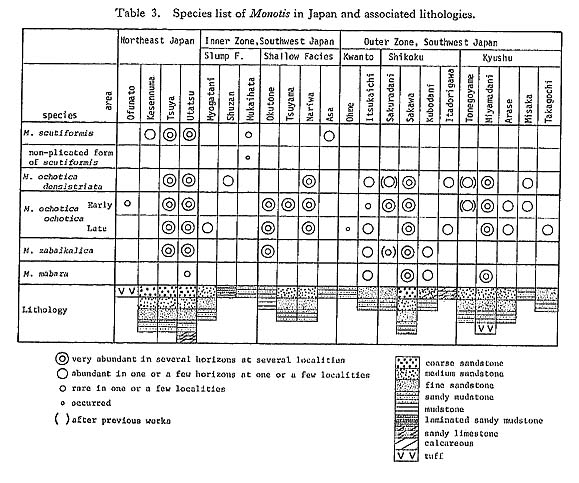
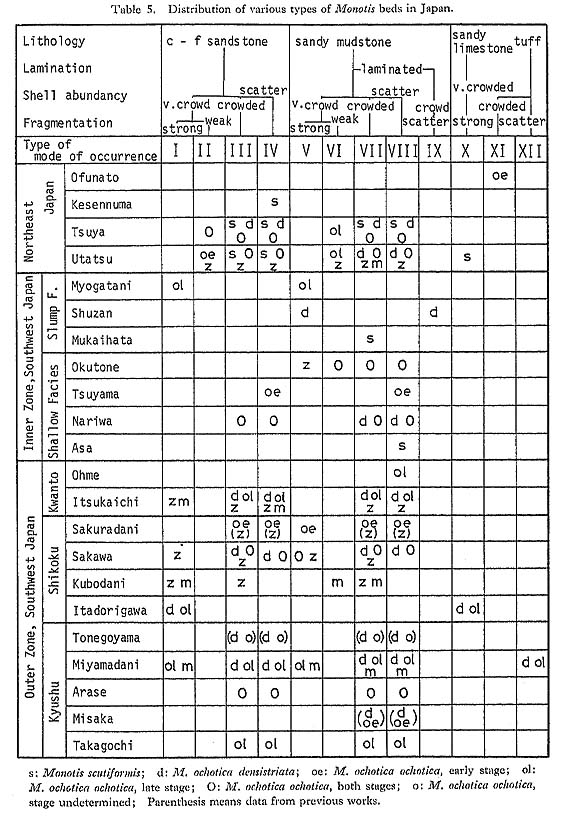
Monotis ochotica (Keyserling, 1848)
Lectotype: The specimen of Avicula Ochotica minor Keyserling (1848, pl. 6, fig, 15) from Mamba Bay, south coast of Okhotsk Sea was subsequently designated as the lecto-type by Ichikawa (1958, p. 182).
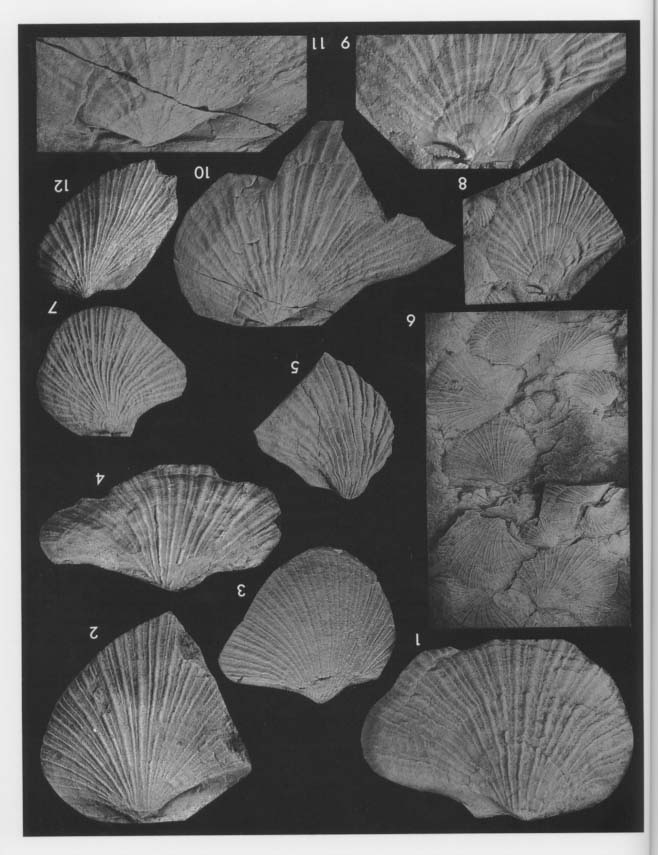
Explanation of Plate 6
Monotis ochotica ochotica (Keyserling)
Okutone samples (locs.: Ok6, 7)
Fig. 1. Left valve, loc.: Ok6, ×1 (MM17608a)
Fig. 2. Right valve, loc.: Ok6, ×1 (MM17608b)
Figs. 3-4. Left valves, loc.: Ok6, ×2/3 (MM17608c, d); Fig. 4. shows conspicuously elongated posterior margin
Fig. 5. Left valve, loc.; Ok6, ×1 (MM17608e)
Fig. 6. Crowded occurrence on a slab of sandy mudstone of type VI. Most valves are in convexup position. Loc.: Ok6, ×1/2 (MM17608a)
Fig. 7. Right valve, loc.: Ok7, ×1 (MM17609)
Figs. 8-9. Right valve, loc.: Ok6, ×1 (MM17608f); Fig. 9 shows dorsal part with pseudoctenoliumn in anteroventral part of anterior auricle. ×2
Figs. 10-11. Right valve, loc.: Ok6, ×1 (MM17608g); Fig. 11 shows dorsal part with external mold of longitudinally striated ligamental area. ×2
Fig. 12. Right valve, loc.; Ok6, ×1 (MM17608h), latex cast from external mold
All except Fig. 12 are internal molds
|
Diagnosis: Medium- to large-sized, rather suboval to slightly posteriorly elongate, strongly inequivalve and moderately inequilateral; posterior wing variable in shape but of moderate size, obscurely to clearly separated and truncated with a nearly right to obtuse angle; number of primary plicae ranging from 8 to 28, varying intra-populationally and stratigraphically. Remarks: The classification of M. ochotica is confused owing to the extremely wide morphological variation. Since Teller (1886) proposed five varieties from Verkhoyansk Range, many varieties and subspecies had been added by various authors. Those infra-specific taxa in many cases were recorded from a single locality. I confirmed that most of these intraspecific names of M. ochotica are at least taxonomically unnecessary, as already described in Chapter 5.
Conspicuous morphological changes seem to have occurred in this evolutionary species. Therefore, I adopt the concept of chronological subspecies (Sylvester-Bradley, 1956), and divide M. ochotica into the early subspecies, M. ochotica densistriata, and the later subspecies, M. ochotica ochotica. The evolutionary change from the first to the second subspecies is of course gradational, and the taxonomic distinction is quite arbitrary.
Pseudomonotis jakutica was a small sized, suboval, subequilateral species proposed by Teller (1886), based on only four right valves. Teller's specimens and other samples including left valves were reexamined by Kiparisova (1932) and Kiparisova et al. (1966). Teller's specimens seem to represent the small valves of M. ochotica densistriata or M. ochotica ochotica of the early evolutionary stage. Furthermore, Westermann (1962) described this species from British Columbia, and analyzed it by a biometrical method. The difference between M. jakutica and M. ochotica densistriata, however, seems to be too slight to divide them into distinct species.
Recently Grant-Mackie (1978a-d, 1980b-c) described a much diversified Monotis
fauna from New Zealand. Some of his specimens may be very similar to M. ochotica, though further comparison at the population level is needed.
Occurrence: This species occurs in many areas in Japan, as shown in Fig. 1 and Tables 3, 5. Abundant in the Western and Northeastern Pacific region (Fig. 38).




Monotis ochotica densistriata (Teller, 1886)
Pl. 2, Figs. 10-12, Pl. 5, Figs, 1-5
Pl. 7, 21-25; Pl. 11, Figs. 1-5
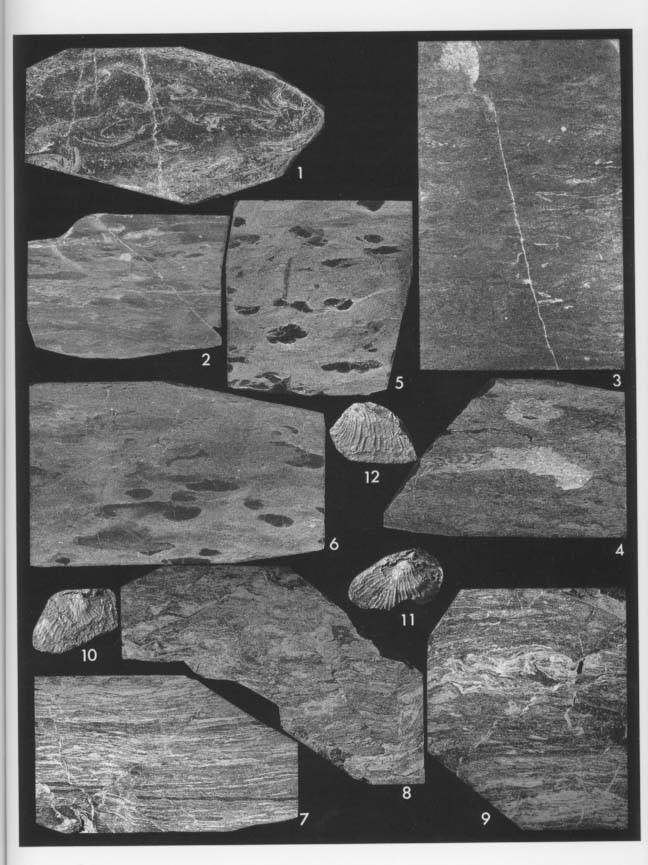
Explanation of Plate 2
Mode of shell occurrence of Monotis, Types VII-IX
Fig. 1. Type VII, massive sandy mudstone with crowded fragmentary shells of Monotis mabara, loc.: Mylq, Miyamadani area (MM17664b), ×1.2
Figs. 2-6. Type VIII, bioturbated heterogeneous sandy mudstone
Fig. 2. With M. ochotica ochotica, loc.: Ok6, Okutone area, ×1 (MM17608i)
Fig. 3. With M. ochotica densistriata, loc.: Na4015c, Nariwa area, ×0.8 (MM17597c)
Fig. 4. With M. scutiformis, loc.: As6, Asa area, ×1 (MM17586f)
Figs. 5-6. With muddy excrement by an epifaunal animal (large and black) and pelletal mud grains,×1
Figs. 7-9. Type IX, thinly laminated sandy shale bearing scattered and partly crowded shells of M. ochotica densistriata, loc.: Sh2, Shuzan area
Fig. 7. Thin alternation of sand and mud layers with minor fragments of Monotis shells, ×1 (MM 17593d)
Fig. 8. Heterogeneous part with minor slump and fault structure, ×0.7 (MM17593e)
Fig. 9. Crowded Monotis shells layer, ×0.45 (MM17593f)
Figs. 1-9. Polished cross sections of rock specimens Monotis ochotica densistriata (Teller), loc.: Sh2, Shuzan area
Fig. 10. Right valve (MM17593a)
Fig. 11. Conjoined valves (MM17593b), view of right valve
Fig. 12. Left valve (MM17593c)
All three specimens are internal molds (×1)
|
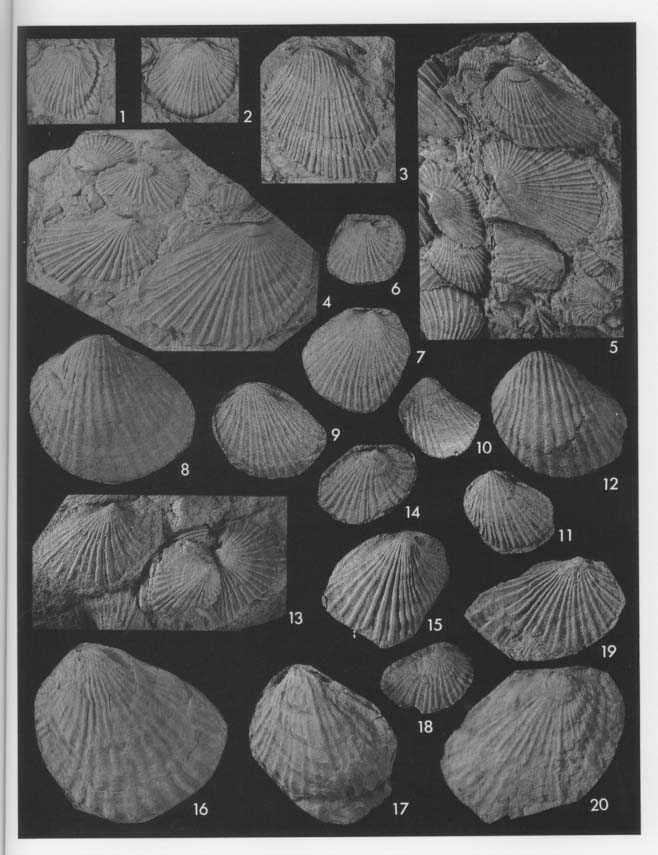
Explanation of Plate 5
Utatsu samples (locs.: Sr3202c-3207)
Monotis ochotica densistriata (Teller)
Fig. 1. Conjoined valves, this side: right valve, loc.: Sr3202c (MM15717)
Fig. 2. Right valve, loc.: Sr3202d (MM17590a)
Fig. 3. Left valve, loc.: Sr3202d (MM17590b)
Figs. 4-5. Very crowded occurrence in sandy mudstone of type VI, loc.: Sr3203a; Fig. 4 (MM15715) shows only right valves; Fig. 5 (MM17592)
Monotis ochotica ochotica (Kcyserling)
Figs. 6-7. Right valves, loc.: 3204b (MM17603a, b)
Figs. 8-12. Left valves, loc.: Sr3205d; Fig. 8 (MM15720) is the specimen on which text-Fig. 27 is mainly based; Figs. 9-12 (MM17605a-d)
Fig. 13. Very crowded occurrence in medium-grained sandstone of type II, loc.: Sr3205d; All are right valves (MM17605e)
Figs. 14-15. Right valves, loc.: Sr3205d (MM17605f, g)
Figs. 16-17. Left valves, loc.: Sr3207; Fig. 16 (MM15727); Fig. 17 (MM17606a)
Figs. 18-20. Right valves, loc.: Sr3207; Figs. 18, 20: latex casts from external molds; Figs. 18-19 (MM17606b, c); Fig. 20 (MM15726)
All are internal molds except Figs. 18, 20 (×1)
|
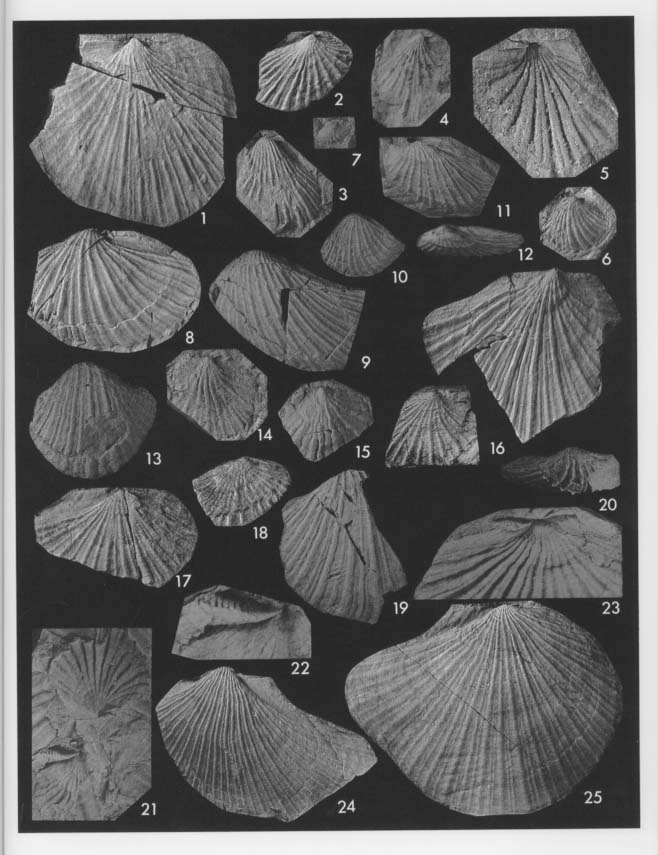
Explanation of Plate 7
Monotis ochotica ochotica (Keyserling)
Tsuyama samples (locs.: Ts1001, 2004, 4007, 4008)
Figs. 1-2. Right valves, loc.: Ts1001b (MM17612a, b)
Fig. 3. Left valve, loc.: Ts1001b (MM17612c)
Figs. 4-7. Right valves, loc.: Ts1001e (MM17614a-c); Fig. 4: latex cast from external cast;
Fig. 5: external mold of the same specimen in Fig. 4, ×2
Figs. 8-12. Left valves, loc.: Ts1001e (MM17614d-g); Fig. 12: dorsal view of latex cast from external molds of the same specimen in Fig, 11 (MM17614g)
Fig. 13. Left valve, loc.: Ts4007 (MM17621a)
Fig. 14. Right valve, loc.: Ts4007 (MM17621b)
Figs. 15-16. Right valves, loc.: Ts4008 (MM17622)
Figs. 17-18. Right valves, loc.; Ts2004c (MM17620a, b)
Figs. 19-20. Left valve, loc.; Ts2004b (MM17619); Fig. 20: dorsal view Monotis ochotica densistriata (Teller)
Nariwa sample (loc. Na1560)
Figs. 21-23. External molds of right valves showing pseudoctenolia on the upper and lower sides of byssal notch. Loc.: Na4015b (MM17596); Fig. 21, ×2; Fig. 22, enlargement of lower part of Fig. 21, ×4; Fig. 23, ×2 (MM17596)
Fig. 24. Left valve, loc.: Na4015c (MM17597a)
Fig. 25. Right valve, loc.: Na4015c (MM17597b)
All are internia molds, except Figs. 4, 5, 12, 21-23. Natural size unless otherwise stated
|


Explanation of Plate 11
Miyamadani samples (locs.: Myla-k)
Monotis ochotica densistriata (Teller)
Fig. 1. Left valve, loc.: Myla (MM17599)
Fig. 2. Left valve, loc.: Mylb (MM17600a)
Figs. 3-4. Right valves, loc.: Mylb (MM17600b, c)
Fig. 5. Left valve, loc.: Myle (MM17601)
Monotis ochotica ochotica (Keyserling)
Figs. 6-9. Left valves, loc.: Myli (MM17637a-d)
Fig. 10. Top: right valve; bottom: finely plicated left valve, loc.: Myli (MM17637e)
Figs. 11-13. Right valves, loc.: Myli (MM17637f-h)
Fig. 14. Very crowded occurrence in sandy mudstone with numerous fragments of type V loc.: Myli (MM17637i)
Figs. 15-16. Left valves, loc.: Mylj (MM17638a, b)
Fig. 17. Left valve, loc.: My 1k (MM 17639a)
Figs. 18-19. Right valves, loc.: Mylk (MM17639b, c)
All are internal molds (×1)
|
1886 Pseudomonotis ochotica var. densistriata Teller, p. 19, pl. 17, figs. 7-8, 13-14, pl. 18, figs. 9-10
1915 Pseudomonotis ochotica Keyserling var, densistriata Teller: Diener, p. 27, pl. 4, fig. 5
1949 Entomonotis ochotica var. densistriata (Teller); Kobayashi and Ichikawa, p. 253, pl. 9, fig. 15
1951b Entomonotis iwaiensis Ichikawa, p. 46, figs. 1, 2
1954a Entomonotis ochotica var. densistriata (Teller): Ichikawa, p. 51
1955 Pseudomonotis (Entomonotis) ochotica var. densistriata (Teller): Tuchkov, p. 608, fig. 1d
1955 Pseudomonotis (Entomonotis) jakutica (Teller): Tuchkov, p. 608, fig. 1c
1962 Monotis ochotica densistriata (Teller): Westermann, p. 774, pl. 114, figs. 1-5
?1962 Monotis jakntica (Teller): Westermann, p. 761, pl. 113, figs. 1-5
1963 Monotis (Entomonotis) jakutica (Teller): Nakazawa, p. 51, pl. 1, figs. 15-17
1964a Monotis (Entomonotis) ochotica densistriata (Teller): Nakazawa, p. 34, pl. 5, figs. 3-5
1964a Monotis (Entomonotis) sp. aff, scutiformis (Teller): Nakazawa, p. 33, pl. 5, figs. 1, 2
1965 Monotis (Entomonotis) ochotica densistriata (Teller): Tamura, p. 50, pl. 1, figs. 3-9
1966 Monotis (Entomonotis) ochotica var. densistriata (Teller): Kiparisova et al., p. 89, pl. 8, figs. 4-5, pl. 9, fig. 1
?1966 Monotis (Entomonotis) jakutica (Teller): Kiparisova, p. 79, pl. 6, figs. 22, 23, pl. 7, figs. 1-5 (non fig. 6)
1985 Monotis iwaiensis (Ichikawa): Payevskaya, p. 76, pl. 1, fig. 13
1985 Monotis ochotica densistriata (Teller): Payevskaya, p. 83, pl. 2, fig. 10, pl, 3, figs. 1, 2
1985 Monotis jakutica (Teller): Payevskaya, p. 94, pl. 6, figs. 1, 2
Lectotype: This subspecies was proposed by Teller (1886) as a variety, based on a left, a right and two conjoined valves. The lectotype was subsequently designated by Westermann (1962) on the left valve of pi. 18, fig. 10 in Teller's figures. Three of Teller's specimens were reexamined and photographed by Kiparisova et al. (1966, p. 89, pi. 8, figs. 4-5, pl. 9, fig. 1).
Material: Specimens on which the following description is based are listed in the appendix.
Diagnosis: Early chronological subspecies of M. ochotica having densely plicated primary and higher-order plicae and obtusely to clearly plicated posterior wing.
Description: The largest specimen exceeds 80 millimeters in length. The outline of two valves extremely varies, from suboval to obliquely elongate. In the adult stage, over 40 millimeters in length, the posterior end is elongated with a sinuation. Right valve is nearly flat to slightly inflated, while the left valve is strongly convex with highly-pro-jected umbonal part above hinge line.
Hinge line is about 2/5 to 3/5 as long as shell length. Posterior wing is rather well developed, though its separation from disc may or may not be clear. Posterior wing of right valve more clearly separated. Truncation angle right to obtuse.
Surface ornamentation consists of about 15 to 30 relatively thin but sharp primaries, regularly inserted secondaries, and irregular third- to fourth-order plicae in larger specimens. Pt exceeds 65 in the largest specimens. Posterior wing is sculptured by some finer and weaker plicae with nearly equal width. Some irregular and fine concentric wrinkles are occasionally developed.
Remarks: Ichikawa (1951b) proposed Entomonotis iwaiensis from the Itsukaichi area. The species was said to be characterized by the auboval, strongly convex and finely plicated left valve with plicated posterior wing, and regarded as characteristic in strati-graphic horizons lower than the E. ochotica Zone. As it is closely similar to the earliest stage of M. ochotica densistriata from the Utatsu area, I do not think that any taxonomic discrimination is necessary for the Itsukaichi specimens.
Monotis ochotica ochotica (Keyserling, 1848)
Pl. 5, Figs, 6-20; Pl. 6; Pl. 7, Figs. 1-20; Pls. 8,
Pl. 10, Figs. 1-9; Pl. 11, Figs, 6-19; Pl. 12, Figs. 1-16; Pl. 13, Figs. 1-6

Explanation of Plate 8
Monotis ochotica ochotica (Keyserling)
Arase samples (locs.: Ar1301a-c)
Figs. 1-6. Loc.: Ar1301c
Figs. 1-4. Left valves (MM17647a-d)
Figs. 5-6. Right valves (MM17647e, f)
Figs. 7-13. Loc.: Ar1301b
Figs. 7-8. Left valves (MM17646a, b)
Figs. 9-13. Right valves (MM17646c-g)
Figs. 14-24. Loc.: Ar1301a
Figs. 14-20. Left valves (MM17645a-f); Fig. 20: dorsal view of Fig. 16 (MM17645c)
Figs. 21-24. Right valves (MM17645g-j)
All are internal molds (×1). Figures are generally arranged stratigraphically in descending order
|

Explanation of Plate 9
Monotis ochotica ochotica (Keyserling)
Takagochi samples (locs.: Ta29, 35)
Figs. 1-8. Loc.: Ta35
Figs. 1-2. Left valve (MM17649a); Fig. 2: dorsal view
Figs. 3-8. Right valves (MM17649b-f); Fig. 5 shows non-plicated umbonal part with irregular cencentric wrinkles; Fig. 6 shows specimens with shallow blunt and roof-shaped plicae (bottom) and one with finer and sharper plicae (top right); Fig. 8 shows dorsal view with striated hinge area of Fig. 7 (text-Fig. 27) (MM17649f), ×2
Figs. 9-22. Loc.: Ta29
Figs. 9-20. Left valves (MM17648a-k); Fig. 9 shows a left valve (left side) with a smaller number of wider, higher and roof-shaped plicae and one (right side) with a larger number of finer and sharper plicae in the same slab of fine-grained sandstone; Fig, 14 is lateral view of the specimen in Fig. 13 (MM17648e)
Fig. 21. Right valves in a slab of fine-grained sandstone of type III (MM176481)
Fig. 22. Right valve (MM 17648m)
All are internal molds (×1) except Figs. 7, 8 of latex cast from external mold
|

Explanation of Plate 10
Monotis ochotica ochotica (Keyserling)
Takagochi sample (loc.: Ta29)
Figs. 1-9. Right valves (MM17648n-u); Figs. 1-3: Three valves show the intergradation of features of posterior wing such as separation, and truncation angle; Fig. 4: latex cast from external mold; Fig. 7, anterior part of the right valve of the same specimens as Fig. 6 (MM17648s), ×2
Monotis mabara (Kobayashi and Ichikawa)
Fig. 10. Crowded occurrence on a slab of calcareous silty sandstone from loc. Ku10d in the Kubodani area, type I, ×2/3 (MM17664)
Fig. 11. Left valve associated with left valve of Monotis zabaikalica (right), loc.: Ku10e, Kubodani area (MM17662)
Figs. 12-14. Left valves, loc. Sk 3009, Sakawa area (MM17658a-c)
Fig. 15. Left valve associated with left valve of M. zabaikalica, type VI, loc.: Sk3009 Sakawa area (MM17658d)
Fig. 16. Left valve, loc.: Sr3407b, Utatsu area (MM17656a)
All are internal molds except Fig. 4, Natural size unless otherwise stated
|
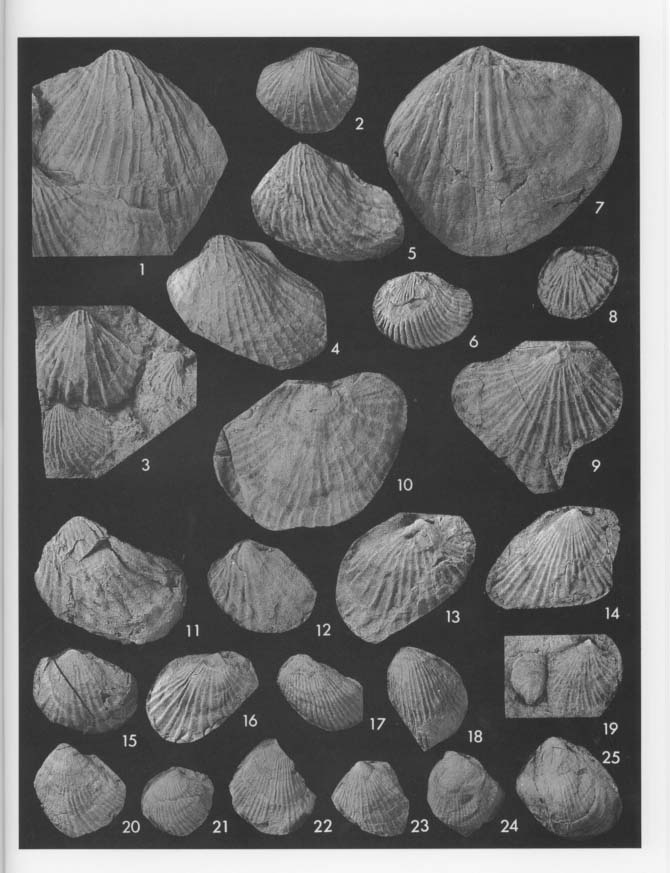
Explanation of Plate 12
Miyamadani samples (locs.: My1l-v)
Monotis ochotica ochotica (Keyserling)
Figs. 1-2. Left valves, loc.: My1l (MM17640a, b)
Figs. 3-7. Left valves, loc.: My1n; type III (MM17641a-e)
Figs. 8-10. Right valves, loc.: My1n (MM17641f-h)
Figs. 11-12. Right valves, loc.: My1o (MM17642a, b)
Figs. 13-14. Right valves, loc.: My1o (MM17642c, d)
Fig. 15. Left valve, loc.: My1p (MM 17643a)
Fig. 16. Right valve, loc.: My1p (MM17643b)
Monotis mabara (Kobayashi and Ichikawa)
Figs. 17-18. Left valves, loc.: My1t (MM17668a, b)
Fig. 19. Right valve with a rhynchonellid brachiopod, loc.: My1r (MM17666)
Fig. 20. Left valve, loc.: My1q (MM17665a)
Fig. 21. Right valve, loc.; My1u (MM17669A)
Fig. 22. Right valve, loc.: My1v (MM17669Ba)
Figs. 23-25. Left valves, loc.: My1v (MM17669Bb-d)
All are internal molds (×1)
|

Explanation of Plate 13
Monotis ochotica ochotica (Keyserling)
Figs. 1-3. Left valves, loc.: Myogatani area (MM17610a-c)
Figs. 4-6. Right valves, loc.: Myogatani area (MM17610d-f); Figs. 5, 6: latex casts from external molds
Monotis zabaikalica (Kiparisova)
Figs. 7-8. Left valves, loc.: Sk3009, Sakawa area (MM17658e, f)
Figs. 9-20. Loc.: Sr3208, 3407b, Utatsu area
Fig. 9. Left: left valve; right: right valves, latex cast from external mold; type IV; loc.: Sr3407b; ×1/2 (MM17656b)
Figs. 10-13. Left valves, loc.: Sr3208; Figs. 10: 3208L5 of text-Fig. 33 (MM15728); Figs. 11-13 (MM17651a-c)
Figs. 14-20. Right valves, loc.: Sr3208; Figs. 14-17, 20 (MM17651d-h); Fig. 18: 3208cR4 of text-Fig. 33 (MM15730); Fig. 19: 3208R11 of text-Fig. 33 (MM15729)
All are internal molds except Figs. 5, 6, 9. Natural size unless otherwise stated
|
1848 Avicula Ochotica minor Keyserling, in Middcndorf, pl. 6, fig. 15
1848 Avicula Ochotica media Keyserling, in Middcndorf, pl. 6, fig. 16
1848 Avicula Ochotica major Keyserling, in Middendorf, pl. 6, fig. 17
1886 Pseudomonotis ochotica (Keyserling): Teller, p. 116, pl. 17, figs. 1-6, 9-12, 15-18
1886 Pseudomonotis ochotica var. sparsicostata Teller, p. 120, pl. 17, fig. 11
1886 Pseudomonotis ochotica var, eurhachis Teller, p. 120, pl. 18, fig. 1
1886 Pseudomonotis ochotica var. ambigua Tcller, p. 121, pl. 18, figs. 3, 5
1886 Pseudomonotis ochotica var, pachypleura Teller, p. 121, pl. 18, figs. 2, 4, 11
1888 Pseudomonotis ochotica (Keyserling): Mqjsisovica, p. 175, pl. 2, figs. 6-8
1915 Pseudomonotis ochotica Keyserling var. eurhachis Teller: Diener, p. 29, pl. 3, fig. 3, pl. 4, figs. 6, 8
1927 Pseudamonofis ochotica (Keyserling): Yehara, p. 29, pl. 4, figs. 1-3
1927 Pseudomonotis ochotica var. eurhachis Teller: Yehara, p. 29, pl. 4, figs. 4, 5
1927 Pseudomonotis sulicirciilaris Gabb: Yehara, p. 30, pl. 4, fig. 6
1935 Pseudomonotis ochotica var. eurhachis Teller: Kobayashi, p. 27, pl. 7, fig. 11
1935 Pseudomonotis ochotica var. pachypleura. Teller: Kobayashi, p. 27, pl. 7, fig. 10
1944 Pseudomonotis ochotica (Keyserling): Takagi, p. 197, fig. 2
1949 Entomonotis ochotica (Keyserling): Kobayashi and Ichikawa, p. 249, pl. 9, fig. 1
1949 Entomonotis ochotica var. eurhachis (Teller): Kobayashi and Ichikawa, p. 252, pl. 9, figs, 2-4
1949 Entomonotis pachypleura (Teller): Kobayashi and Ichikawa, p. 256, pl. 9, fig. 10
1949 Entomonotis ambigua (Teller): Kobayashi and Ichikawa, p. 255, pl. 9, figs. 9, 13
1949 Entomonotis multistriata Kobayashi and Ichikawa, p. 255, pl. 9, figs. 11, 14
1954a Entomonotis ochotica (Keyserling): Ichikawa, p. 51
1954a Entomonotis ochotica var. eurhachis (Teller): Ichikawa, p. 51
1961 Monotis ochotica wingia Bando, p. 4, pl. 1, figs. 1, 2
1962 Monotis ochotica posteroplana Westermann, p. 777, pl. 114, figs. 8-10, pl. 115, figs. 1-3
1962 Monotis ochotica cf. M. o. posteroplana Westermann, p. 780, pl. 114, figs. 6-7
1962 Monotis cf. M. pachypleura hemispherica Trechmann: Westermann, p. 780, pl. 115, fig. 4
1963 Monotis (Entomonotis) ochotica (Keyserling): Nakazawa, p. 52
1963 Monotis (Entomonotis) ochotica sparsicostata (Teller): Nakazawa, p. 52, pl. 2, figs. 1-4
1963 Monotis (Entomonotis) ochotica jitoensis Nakazawa, p. 52, pl. 2, figs. 5-7
1963 Monotis (Entomonotis) sublaevis (Teller): Nakazawa, p. 49, pl. 1, figs. 7, 8
1963 Monotis (Entomonotis) aff. sublaevis (Teller): Nakazawa, p. 50, pl. 1, figs. 9, 10
1965 Monotis (Entomonotis) ochotica ochotica (Keyserling): Tamura, p. 50, pl. 1, figs. 10-12
1965 Monotis (Entomonotis) sparsicostata (Teller): Tamura, p. 51, pl. 1, fig. 13
1965 Monotis (Entomonotis) ochotica eurhachis (Teller): Tamura, p. 51, pl. 1, figs. 14, 15, pl. 1, fig. 1
1965 Monotis (Entomonotis) ambigua (Teller): Tamura, p. 51, pl. 3, fig. 7
1965 Monotis (Entomonotis) pachypleura (Teller): Tamura, p. 52, pl. 2, figs. 4-6
1965 Monotis (Entomonotis) multistriata Kobayashi and Ichikawa: Tamura, p. 52, pl. 2, figs. 9-12
1965 Monotis (Entomonotis) jakutica (Teller); Tamura, p. 52, pl, 2, figs. 13-15
1966 Monotis (Entomonotis) ochotica (Keyserling) s. s.: Kiparisova et al., p. 86, pl. 7, figs. 10-12, pl. 8, figs. 2, 3
1966 Monotis (Entomonotis) ochotica var. eurhachis (Teller): Kiparisova et a.l, p. 92, pl. 9, figs. 4. 5
1966 Monotis (Entomonotis) ochotica var. aequicostata Kiparisova: Kiparisova, p. 94, pl. 9, figs. 6-8, pl, 10, fig. 1
1966 Monotis (Entomonotis) ochotica var. pachypleura (Teller): Kiparisova, p. 95, pl. 10, figs. 2-6
1966 Monotis (Entomonotis) ochotica var. ambigua (Teller): Kiparisova, p. 97, pl. 10, figs. 7-9
1966 Monotis (Entomonotis) ochotica var. posteroplana (Teller): Kiparisova, p. 98, pl. 10, fig. 10, pl. 11, figs. 1-7
1967 Monotis ochotica ochotica (Keyserling): Westermann and Verma, p. 802, fig. 3
1976 Monotis (Entomonotis) ochotica (Keyserling): Chen and Yu, p. 227, pl. 38, fig, 9
1976 Monotis (Entomonotis) ochotica baogingensis Chen and Yu, p. 227, pl, 39, figs. 1, 2
1985 Monotis ochotica ochotica (Keyserling): Payevskaya, p. 82, pl. 2, figs. 6-9
1985 Monotis pachypleura (Teller): Payevskaya, p. 84, pl. 3, figs. 3-8, pl. 4, figs. 1-4
1985 Monotis sparsicostata (Teller): Payevskaya, p. 90, pl. 4, figs. 5-9
1985 Monotis longa (Kiparisova): Payevskaya, p. 92, pl, 4, fig. 10
1985 Monotis posteroplana Westermann: Payevskaya, p. 93, pl, 5, figs. 1-4
1985 Monotis jakutica (Teller): Payevskaya, p. 94, pl. 5, figs. 5-7 (non pl. 6, figs. 1, 2)
1985 Monotis jitoensis Nakazawa: Payevskaya, p. 96, pl. 6, fig. 3
1985 Monotis sublaevis (Teller): Payevskaya, p. 100, pl. 7, figs. 7, 8
1985 Monotis cycloidea (Teller): Payevskaya, p. 103, pl. 7, fig. 10
Lectotype: See description of M. ochotica.
Material: Specimens on which the following description is based are listed in the appendix.
Diagnosis: Late chronological subspecies of M. ochotica having conspicuous radial plicae, which are highly variable in thickness but comparatively small in number; secondaries and tertiaries less frequent.
Description: The shell outline is nearly the same as M. ochotica densistriata. The surface ornamentation consists of 8 to 25 relatively sharp and thick primary plicae, irregularly inserted and much weaker secondaries, and rare and irregular tertiaries. Depending upon horizons, the plicae are fairly variable in strength, width undulation and insertion pattern of higher orders, as follows:
Early stage: About 10 to 25, equal sized, sharp, strong primaries, and regularly inserted weaker secondaries and irregularly inserted tertiaries; represented by specimens from the Utatsu (Pl. 5, Figs. 6-15), Okutone (Pl. 6), Tsuyama (Pl. 7, Figs. 1-20), and Arase (Pl. 8, Figs. 14-24) areas.
Late stage: About 8 to 20, very thick to fine, strong to obsolete primaries, and irregularly inserted weaker secondaries; posterior part frequently obscurely plicated and irregularly rugate; some specimens having 8 to 10, strongly undulate plicae, some having wider but low primaries with few higher-order plicae and some having obsolete plication on the whole surface; most have varied plication in three stages; represented by specimens from the Utatsu (Pl. 5, Figs. 16-20), Myogatani (Pl. 13, Figs. 1-6), Arase (Pl. 8, Figs. 1-13), Takagochi (Pl. 9; Pl. 10, Figs. 1-9) and Miyamadani (Pl. 11, Figs. 6-19; Pl. 12, Figs. 1-10) areas.
Latest stage: About 12 to 20, equal sized, low and wide to sharp and finer primaries, and irregularly inserted weaker secondaries; represented by specimens from the Miyamadani area (Pl. 12, Figs. 11-16).
Remarks: This subspecies seems to include many forms which have been regarded as subspecies or varieties by a several authors since Teller (1886).
Kobayashi and Ichikawa (1949) proposed Entomonotis multistriata from the Sakawa area, but it seems to be equivalent to the latest stage of this subspecies.
The name of Pseudomonotis sublaevis Teller was applied by Nakazawa (1963) to right valves with a non-plicated umbonal part from the Nariwa area, but these may be also an aberrant form of this subspecies.
Monotis zabaikalica (Kiparisova, 1936)
Pl. 10, Figa, 11, 15; Pl. 13, Figs. 7-20; Pl. 14

Explanation of Plate 14
Monotis zabaikalica (Kiparisova)
Utatsu samples (locs.: Sr3209-3213)
Figs. 1-4. Left valves, loc.: Sr3209; Figs. 1-3 (MM17652a-c); Fig. 4 (MM15732)
Figs. 5-9. Right valves, loc.: Sr3209; Figs. 5-7 (MM17652d-f); Fig. 8: 3209R6 of text-Fig. 33 (MM15731); Fig. 9: 3209R1 of text-Fig. 33 (MM15733)
Figs. 10-12. Left valves, loc.: Sr3210; Fig. 10 (MM17653a); Fig. 11 (MM15735); Fig, 12 (MM17653b)
Figs. 13-14. Right valves, loc.: Sr3210; Fig. 13 (MM17653c); Fig. 14 (MM15736)
Fig. 15. Posterior view of left valve, loc.: Sr3210 (MM15734)
Fig. 16. Left valve, loc.: Sr3213 (MM15737)
Fig. 17. Right valve, loc.: Sr3213 (MM15738)
Fig. 18. Left valve, loc.: Sr3213 (MM17655)
All are internal molds (×1)
|
1932 Monotis sp, nov. indet., Kiparisova, p. 21, pl. 2, figs. 12, 13 (not seen)
1936 Pseudomonotis zabaikalica Kiparisova, p. 81, pl. 1, fig. 5
1936 Pseudomonotis aff. zabaikalica. Kiparisova, p. 81, pl, 1, fig. 4
1936 Pseudomonotis sp. nov. indet, Kiparisova, p. 81, pl. 1, figs. 1-3
1939 Entomonotis kurosawai Sakaguti, p. 229, pl. 15, figs. 1-6
1949 Entomonotis zabaikalica (Kiparisova); Kobayashi and Ichikawa, p. 257, pl. 10, figs. 12-18
1949 Entomonotis zabaikalica var. intermedia Kobayashi and Ichikawa, p, 258, pl. 10, figs. 19-20
1958 Monotis (Entomonotis) zabaikalica semiradiata Ichikawa, p. 139 (mentioned only)
1965 Monotis (Entomonotis) zabaikalica (Kiparisova); Tamura, p. 52, figs. 2, 3, 23
1966 Monotis (Entomonotis) zabaikalica Kiparisova; Kiparisova et al., p. 81, pl. 7, fig. 7, pl. 8, fig.l
1985 Monotis zabaikalica (Kiparisova): Payevskaya, p. 98, pl. 6, figs. 6-8
1985 Monotis semiradiata Ichikawa: Payevskaya, p. 100, pl. 6, fig. 9, pl. 7, fig. 1
1985 Monotis notabilis Oleynikov and Payevskaya: Payevskaya, pl. 7, figs, 2-4
1985 Monotis planocostata Kiparisova: Payevskaya, pl. 7, figs, 5, 6
Lectotype: A left valve, described by Kiparisova (1932, pl. 2, fig. 13) as Monotis sp. nov. indet. and named Pseudomonotis zabaikalica by the same author (1936), was designated as the lectotype by Kiparisova et al. (1966).
Material: Specimens on which the following description is based are listed in the appendix.
Diagnosis: Medium- to large-sized, obliquely oval in early stage, ventrally and posteriorly elongate and subquadrate in adult stage; moderately inequivalve and strongly inequilateral; left valve usually more strongly convex than right; posterior wing large and nearly flat, obscurely demarcated from the disc by straight ridges; shell ornamen tation variable in strength and distribution, depending on the growth stage and strati-graphic horizon; concentric wrinkles or folds distributed at irregular intervals but rarely developed in the younger stage; radial plicae gradually become obsolete and sometimes are entirely absent even in a early growth stage; byssal auricle comparatively large for Monotis and byssal notch deep.
Description: Moderate to large, exceeding 80 millimeters in maximum length. The outline of two valves is generally obliquely oval but there is a wide variation. The outline is suboval, resembling M. ochotica in the younger stage, but posteriorly elongated and ventrally expanded in the later stage. While the left valve is strongly inflated, the right valve is weakly or moderately convex. Umbo projects considerably upward and inward above hinge line in left valve, but only slightly in right valve.
Hinge part is more linear and longer in comparison with M. ochotica. Anterior hinge part of left valve is rather short and continues to the anterior part which is usually rounded. Anterior hinge line of right valve is gently and sigmoidally curved from umbo to anterior margin through concave part under byssal notch. Straight posterior end of hinge line is abruptly truncated with an obtuse angle of about 120° to 150°. Posterior wing is comparatively large, triangular or wedge-shaped, and obtusely separated from disc by an obscure ridge. Posterior margin of posterior wing nearly straight and oblique, is never sinuated except in young growth stage. Posterior margin of disc is generally elongate and strongly curved after the middle growth stage. Postero-ventral margin is usually slightly curved and continues to semi-circular anterior margin through the strongly curved ventral extremity.
The shell sculpture is composed of primary, and rarely secondary, radial plicae and irregular concentric wrinkles which exhibit surprising variations in number and strength. Generally radial plicae are much weakened and often disappear with growth. Sometimes radial plicae abruptly disappear at the intersection with concentric wrinkles which also vary in the stage of their appearance within one population sample (Fig. 33). Moreover, in the specimens from the upper horizon, radial plicae disappear at an earlier growth stage. The frequency distribution of Pp is rather bimodal. Pt is 20 to 24 at the maximum. The frequency of non-plicated specimens increases stratigraphically upwards in the typical Shirayamazawa section of the Utatsu area (Figs. 29, 36). Posterior wing is not sculptured but smooth. Concentric wrinkles are particularly prominent in non-plicated regions.

Byssal auricle, which is 6.5 mm long and 1.5 mm wide, at the maximum, points dorsolaterally at first and parallel to hinge line later. Byssal notch is narrow.
Though other samples from the Okutone and Sakawa areas are not necessarily well preserved, they show no significant morphological difference. The chronological change of morphology can be recognized only in the Utatsu samples. Other solitary samples seem to represent later stages in which radial plicae become obsolete.
Remarks: As Kiparisova (1936) and Kobayashi and Ichikawa (1949) pointed out, this species shows a wide range of variations in sculpture. As shown in Pis. 13, 14 even though plicated shells are associated with non-plicated ones in the same population sample, the ontogenetic change of outline and the combination of concentric wrinkles and radial plicae indicate that these specimens belong to a single species with extremely wide continuous variations.
M. zabaikalica semiradiata Ichikawa, 1958, was the emended name for Entomonotis zabaikalica var. intermedia Kobayashi and Ichikawa, 1949 (non Monotis intermedia De Gregoria, 1930 and M. salinaria var. intermedia Trechmann, 1917). This subspecies is only a varietal form of M. sabaikalica with prominent radial plicae from the middle stratigraphic horizon of the zone, which seems to be correlative with loc. Sr3209 in. the Utatsu area.
As a result of my study of the types of Entomonotis knrosawai Sakaguchi, 1939, I found the species to be synonymous with M. sabaikalica. The type specimens were probably collected from loc. Sr3407 of the present paper (Fig. 20).
Ichikawa (1954b) stated that M. zabaikalica is associated with M. pachypleura, M. ochotica densistriata, M. ochotica ochotica and M. eurhachis in the lowest part of zone S7. This may be a result of splitting a population sample of M. zabaikalica (probably from some locality near Sr3208 of this paper) into several morphological species and sub species. Some of Ichikawa's specimens, however, may be referable to M. mabara in this paper which is, though rarely, associated with M. sabaikalica.
Recently, Payevskaya (1985) recognized M. zabaikalica var. planocostata, Kiparisova, 1960 as a distinct species. Taking the shell outline and absence of radial plicae on the peripheral part into account, the two right valves figured on pl. 7 seem to be bluntly plicated individuals from the lower part of the Monotis sabaikalica Zone.
Occurrence: This species occurs in seven areas, namely Tsuya, Utatsu, Okutone, Sakawa, Kubodani, Itsukaichi and Sakuradani (Tables 3, 5, Fig. 19, Appendix). The occurrence from the last area is recorded following Ichikawa (1954a), because additional, material was not obtained. Geographic distribution in the world is shown in Fig. 38, and is restricted to cast Siberia and Japan.
Monotis mabara (Kobayashi and Ichikawa, 1949)
Pl. 10, Figs. 10-16; Pl. 12, Figs. 17-25
1949 Entomonotis tenuicostata Kobayashi and Ichikawa, p. 259, pl. 9, figs. 6, 7: non Monotis tenuicostata Kittl, 1912
1949 Entomonotis tenuicostata var. mabara Kobayashi and Ichikawa, p. 260, pl. 9, fig. 8
1965 Monotis (Entomonotis) tenuicostata Kobayashi and Ichikawa: Tamura, p. 53, pl. 2, figs. 16-22
?1966 Monotis (Entomonotis) jakutica (Teller): Kiparisova et at., p. 79, pl. 7, fig. 6
1985 Monotis tenuicostata (Kobayashi and Ichikawa): Payevskaya, p. 96, pl. 6, figs. 4, 5
Holotype: The holotype of this species is an internal mold of a left valve from the Kochigatani Group of the Sakawa area, which was designated by Kobayashi and Ichi-kawa (1949, pl. 8, fig. 8; UMUT MM5278) as the holotype of Entomonotis tenuicostata var. mabara.
Material: Specimens on which the following description is based are listed in the appendix.
Diagnosis: Small-sized, subround but inequilateral in outline; left valve strongly convex, with rather large umbo which is strongly incurved and tapering to a feebly prosogyrous beak; right valve moderately or weakly convex, with minute byssal auricle; posterior wing very small, hardly demarcated and truncated at an obtuse angle; surface ornamented with 18 to 34, fine and narrow primary plicae and several irregularly inserted secondaries; posterior wing rarely with several very fine plicae.
Description: Shells are smaller than 35 mm in length. The outline varies from obliquely oval to subequilaterally subcircular because many of specimens are subject to secondary deformation. While left valve is more strongly convex with relatively large umbo projected high above hinge line, right valve is moderately or weakly convex. Hinge line is rather short and immediately continues to anterior margin and postero-dorsal margin which is gently curved upward. Posterior wing, short and small, is hardly demarcated from disc and rarely has several fine plicae. Its posterior end is roundly truncated with an obtuse angle of 120° to 150°.
Shell sculpture is composed of 18 to 34, fine and sharp primary plicae of nearly equal strength and some secondary plicae of irregular intervals. Concentric wrinkles are rare.
Comparison: This species differs from M. ochotica in the small size, short hinge line, poorly defined posterior wing and fine and dense plicae. Secondary plicae are rather rare and irregularly inserted in the present species. It is distinguishable from M. scutiformis in shell outline, strong convexity and smaller number of primary and especially secondary plicae.
Remarks: After Entomomtis tenuicostata and E. tenuicostata var, mabara were proposed by Kobayashi and Ichikawa (1949), its homonymous relation to Monotis tenui costata Kittl, 1912 was pointed out by Westermann (1962, p. 758). According to ICZN article 45, however, var. mabara is still available as a species-group name, us long as E. tenuicostata Kobayashi and Ichikawa is accepted as a distinct species. The present species sometimes resemble M. ochotica densistriata and M. ochotica ochotica in shell outline and surface ornamentation. But comparison of population samples enables me to distinguish these taxa from one another. The stratigraphic relation is best confirmed in the Miyamadani section (Fig. 21).
The small right valve, recognized as M. jakutica by Kiparisova et al. (1966, pl. 7, fig. 6), is similar to this species in having a small, rounded outline and fine plicae. Though the detailed stratigraphical occurrence was not described, the valve may belong to M. mabara.
Occurrence: This species occurs in four areas: Utatsu, Sakawa, Kubodani and Miyamadani (Tables 3, 5, Figs. 1, 19, Appendix). It has not been recognized in other countries.
|